经典中的经典 已故名师 GMAT白勇语法总结
- 格式:doc
- 大小:128.50 KB
- 文档页数:11
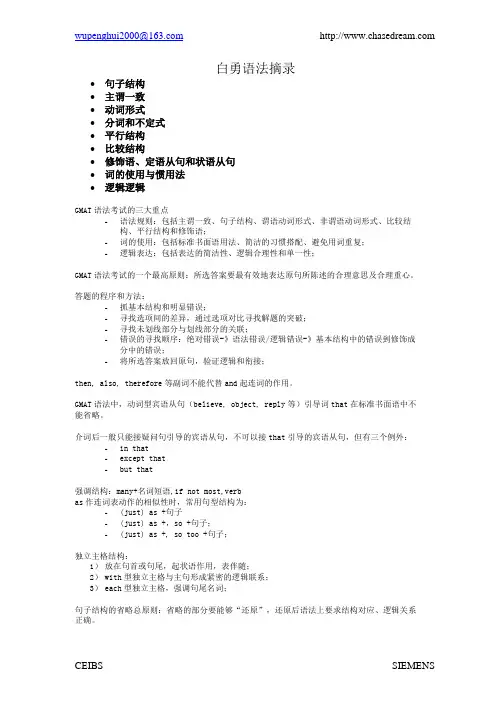
白勇语法摘录∙句子结构∙主谓一致∙动词形式∙分词和不定式∙平行结构∙比较结构∙修饰语、定语从句和状语从句∙词的使用与惯用法∙逻辑逻辑GMAT语法考试的三大重点-语法规则:包括主谓一致、句子结构、谓语动词形式、非谓语动词形式、比较结构、平行结构和修饰语;-词的使用:包括标准书面语用法、简洁的习惯搭配、避免用词重复;-逻辑表达:包括表达的简洁性、逻辑合理性和单一性;GMAT语法考试的一个最高原则:所选答案要最有效地表达原句所陈述的合理意思及合理重心。
答题的程序和方法:-抓基本结构和明显错误;-寻找选项间的差异,通过选项对比寻找解题的突破;-寻找未划线部分与划线部分的关联;-错误的寻找顺序:绝对错误-》语法错误/逻辑错误-》基本结构中的错误到修饰成分中的错误;-将所选答案放回原句,验证逻辑和衔接;then, also, therefore等副词不能代替and起连词的作用。
GMAT语法中,动词型宾语从句(believe, object, reply等)引导词that在标准书面语中不能省略。
介词后一般只能接疑问句引导的宾语从句,不可以接that引导的宾语从句,但有三个例外:-in that-except that-but that强调结构:many+名词短语,if not most,verbas作连词表动作的相似性时,常用句型结构为:-(just) as +句子-(just) as +,so +句子;-(just) as +, so too +句子;独立主格结构:1)放在句首或句尾,起状语作用,表伴随;2)with型独立主格与主句形成紧密的逻辑联系;3)each型独立主格,强调句尾名词;句子结构的省略总原则:省略的部分要能够“还原”,还原后语法上要求结构对应、逻辑关系正确。
并列结构中的省略:省略相同的主语、宾语、连系动词、助动词、情态动词;但实义动词不能省略。
believe sth. that永远错,因为believe不能接双宾语;动作的目的用for doing永远错;名词的否定形式:not A, but B;not A, but rather B;A, rather than B;A, not B;as yet: 至今,到那时为止;代词若在从句中做主语,那么它一定是指代主句中的主语,无论距离多远。
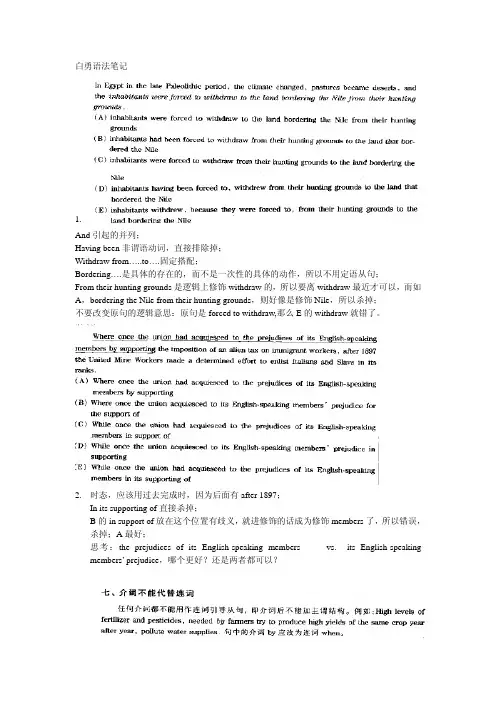
白勇语法笔记1.And引起的并列;Having been非谓语动词,直接排除掉;Withdraw from…..to….固定搭配;Bordering….是具体的存在的,而不是一次性的具体的动作,所以不用定语从句;From their hunting grounds是逻辑上修饰withdraw的,所以要离withdraw最近才可以,而如A,bordering the Nile from their hunting grounds,则好像是修饰Nile,所以杀掉;不要改变原句的逻辑意思:原句是forced to withdraw,那么E的withdraw就错了。
2.时态,应该用过去完成时,因为后面有after 1897;In its supporting of直接杀掉;B的in support of放在这个位置有歧义,就进修饰的话成为修饰members了,所以错误,杀掉;A最好;思考:the prejudices of its English-speaking members vs. its English-speaking members’ prejudice,哪个更好?还是两者都可以?习惯搭配,It may be well that….. it may be that….. 宾语从句的that一般不省略。
同位的时候,你想同位谁,就要离谁最近。
思考一下关于语序的问题:Gmat是怎么考察的?看一下上面这个句子,of….of….of…..这个结构是可以的。
以省略,其他词语都无法省略。
P212页33题至39题没有做。
Although producer prices rose at an unexpectedly steep rate in September, analysts said that the increase resulted mostly from temporary factors.The lack of clarity results in the implication that the system might have founded a school or left behind disciples.This is an unfortunate result of an adverb's ability to pop up almost anywhere in a sentence ....thereby improving stability in flight and resulting in longer throws.The honeybee’s stinger is heavily barbed and stays where it is inserted, with the result that the act of stinging causes the bee to sustain a fatal injury. 这个句子和上面这个句子是很相似的,上面这个句子因为主谓不一致,所以需要用with the result that…来连接两个句子,而不能用result in及result from,因为是整个事件导致了事情本身。
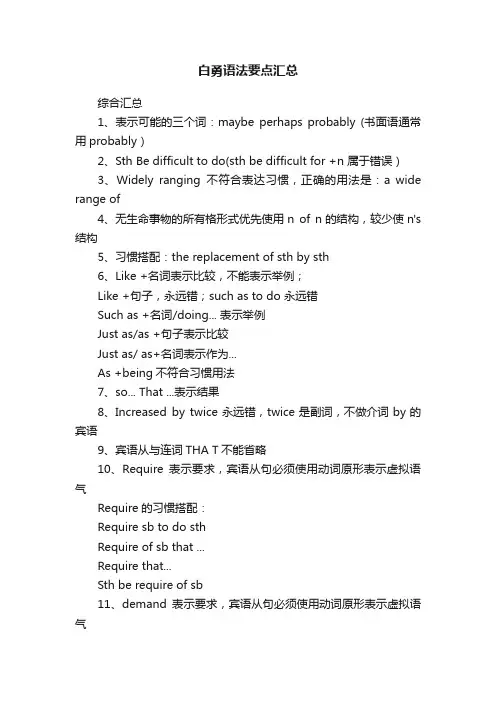
白勇语法要点汇总综合汇总1、表示可能的三个词:maybe perhaps probably (书面语通常用probably)2、Sth Be difficult to do(sth be difficult for +n 属于错误)3、Widely ranging不符合表达习惯,正确的用法是:a wide range of4、无生命事物的所有格形式优先使用n of n的结构,较少使n's 结构5、习惯搭配:the replacement of sth by sth6、Like +名词表示比较,不能表示举例;Like +句子,永远错;such as to do 永远错Such as +名词/doing... 表示举例Just as/as +句子表示比较Just as/ as+名词表示作为...As +being不符合习惯用法7、so... That ...表示结果8、Increased by twice永远错,twice是副词,不做介词by的宾语9、宾语从与连词THA T不能省略10、Require表示要求,宾语从句必须使用动词原形表示虚拟语气Require的习惯搭配:Require sb to do sthRequire of sb that ...Require that...Sth be require of sb11、demand表示要求,宾语从句必须使用动词原形表示虚拟语气Demand的习惯搭配:Demand n from/for nDemand that ...Demand to do...12、be estimated to do/be estimated to be 比较常用,be estimated as doing 属于错误搭配13、That which =what14、As +n 表示作为...15、None of+名词,表示全部否定Not all+名词,表示部分否定16、in effect +ing分词短语在句尾作伴随状语17、Thus 的正确用法是:句子,thus+doing (thus +n永远错)18、不定式并列有两种形式:To do ...and to do...To do ...and do(第一个不定式to必须保留,后面的可以省略)19、while+介词短语错while being 不简洁,应用as 代替20、Older as 永远错,应用:older than, as old as21、Despite+there being 永远错,正确的用法是:despite+名词短语22、表示某人有某种能力做某事时:Can do >be able to do>has(have)ability to do >has (have)a capablity of doing1、allow sb to do...,allow表示允许Allow that ,allow表示承认,that从句不使用动词原词表示虚拟语气2、As many as +复数名词3、Not any =no4、Merge...with...表达才正确,不能用merge A and B5、名词的单数形式可以泛指一类东西,如:A human being 泛指人不能用one human being6、after+when 从句,永远错正确的用法是:after +名词/ing形式After+主谓结构7、被动语态中,by+名词,表示动作的执行者;by+doing表示动作的方式8、习惯搭配:keep sb from doingKeep sth under control 对某事加以控制9、Mandate+that从句,that从句必须使用动词原形表示虚拟语气Mandate sb to do10、Necessity for sb 不符合习惯用法The importance +that / the need+that 从句永远错正确的搭配是:The importance of +n ; the need to do ;The need for sb to do ;the need for sbNecessary的习惯用法:be necessary to doBe necessary for /in doing 永远错11、the proposal of doing 搭配错误,正确的是:The proposal to do...12、习惯用法:Use sth as sth或者use sth to do sth1、比较对象从副的名词尽可能用:that(单数)/those(复数)代替2、比较从句谓语与主句谓语相同,可用do、did 、done代替3、习惯搭配:As+adj+a/an+n+as...(比较两个人或事物在某方面相同时)4、more because...than because...更多的因为为不是因为5、Not...so much A as A与其说A 倒不如说B6、The more ...the more...越...越...7、Like/unlike+名词,一般放在句首表示比较,不放在句尾8、Model A after B 仿照模仿9、In contrast with 和...形成对比In contrast to 和,,,对比和...相反10、more ...than ... / as...as11、As against being...永远错12、Higher numbers of 永远错,正确应该是:A higher number of13、不可数名词不能用不定冠词a/an来修饰14、Threat to 为正确搭配,不能用threat+名词短语15、Is isolation (from)表达不简洁,应该用isolate from16、当一个事物属于与它所属的种类比较时,必须用other把它自身排除从属范围之外:Any+other+n 语气强烈,any不能省略17、as old as 结构前面不能够加数量词。
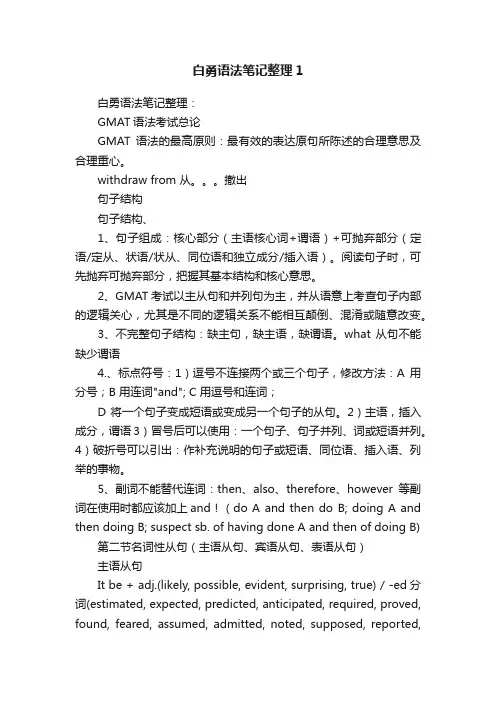
白勇语法笔记整理1白勇语法笔记整理:GMAT语法考试总论GMAT语法的最高原则:最有效的表达原句所陈述的合理意思及合理重心。
withdraw from 从。
撤出句子结构句子结构、1、句子组成:核心部分(主语核心词+谓语)+可抛弃部分(定语/定从、状语/状从、同位语和独立成分/插入语)。
阅读句子时,可先抛弃可抛弃部分,把握其基本结构和核心意思。
2、GMAT考试以主从句和并列句为主,并从语意上考查句子内部的逻辑关心,尤其是不同的逻辑关系不能相互颠倒、混淆或随意改变。
3、不完整句子结构:缺主句,缺主语,缺谓语。
what 从句不能缺少谓语4.、标点符号:1)逗号不连接两个或三个句子,修改方法:A 用分号;B 用连词"and"; C 用逗号和连词;D 将一个句子变成短语或变成另一个句子的从句。
2)主语,插入成分,谓语3)冒号后可以使用:一个句子、句子并列、词或短语并列。
4)破折号可以引出:作补充说明的句子或短语、同位语、插入语、列举的事物。
5、副词不能替代连词:then、also、therefore、however等副词在使用时都应该加上and!(do A and then do B; doing A and then doing B; suspect sb. of having done A and then of doing B) 第二节名词性从句(主语从句、宾语从句、表语从句)主语从句It be + adj.(likely, possible, evident, surprising, true) / -ed分词(estimated, expected, predicted, anticipated, required, proved, found, feared, assumed, admitted, noted, supposed, reported,suggested, decided, noticed) +thatIt + seem/happen/ appear+ that...It be + 名词词组(good news to sb. , a fearful disappointment to sb.,) + that...只能使用陈述语序带有主语从句的复合句中,主语从句作为一个整体,视为单数,谓语动词用第三人称单数主语从句可以并列3、习惯搭配:It may well (很可能) be that…; It may be that...二、宾语从句(动词型宾语从句、介词型宾语从句)1、动词型宾语从句引导词that一般不能省略,省略算作性对性错误。
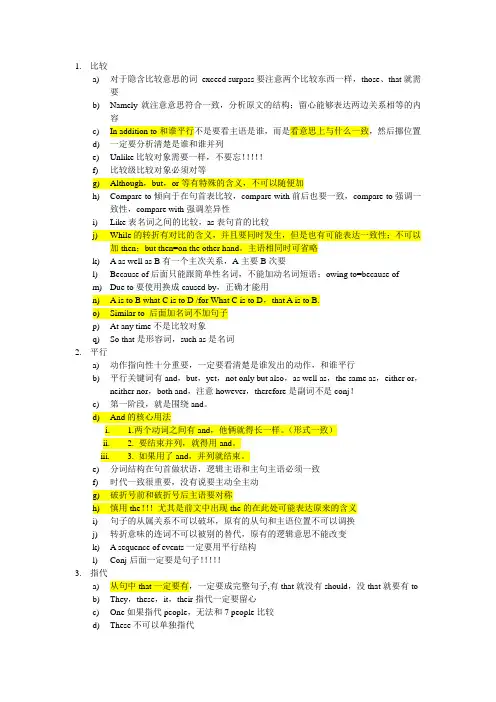
1.比较a)对于隐含比较意思的词exceed surpass要注意两个比较东西一样,those、that就需要b)Namely就注意意思符合一致,分析原文的结构;留心能够表达两边关系相等的内容c)In addition to和谁平行不是要看主语是谁,而是看意思上与什么一致,然后挪位置d)一定要分析清楚是谁和谁并列e)Unlike比较对象需要一样,不要忘!!!!!f)比较级比较对象必须对等g)Although,but,or等有特殊的含义,不可以随便加h)Compare to倾向于在句首表比较,compare with前后也要一致,compare to强调一致性,compare with强调差异性i)Like表名词之间的比较,as表句首的比较j)While的转折有对比的含义,并且要同时发生,但是也有可能表达一致性;不可以加then;but then=on the other hand。
主语相同时可省略k) A as well as B有一个主次关系,A主要B次要l)Because of后面只能跟简单性名词,不能加动名词短语;owing to=because ofm)Due to要使用换成caused by,正确才能用n) A is to B what C is to D /for What C is to D,that A is to B.o)Similar to 后面加名词不加句子p)At any time不是比较对象q)So that是形容词,such as是名词2.平行a)动作指向性十分重要,一定要看清楚是谁发出的动作,和谁平行b)平行关键词有and,but,yet,not only but also,as well as,the same as,either or,neither nor,both and,注意however,therefore是副词不是conj!c)第一阶段,就是围绕and。
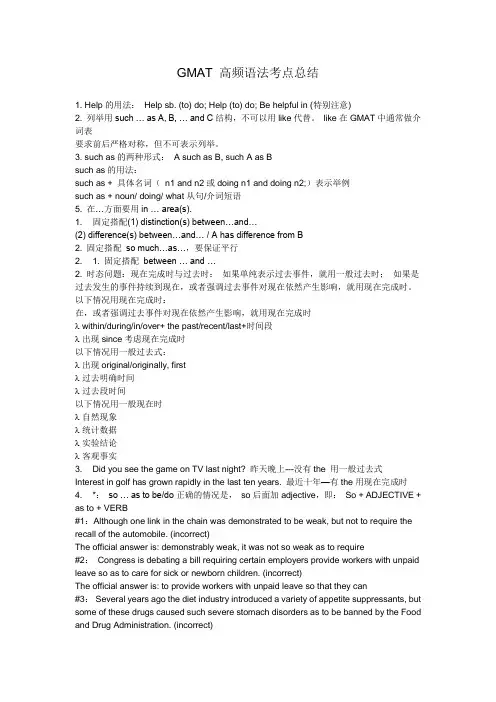
GMAT 高频语法考点总结1. Help的用法:Help sb. (to) do; Help (to) do; Be helpful in (特别注意)2. 列举用such … as A, B, … and C结构,不可以用like代替。
like在GMAT中通常做介词表要求前后严格对称,但不可表示列举。
3. such as的两种形式:A such as B, such A as Bsuch as的用法:such as + 具体名词(n1 and n2或doing n1 and doing n2;)表示举例such as + noun/ doing/ what从句/介词短语5. 在…方面要用in … area(s).1. 固定搭配(1) distinction(s) between…and…(2) difference(s) between…and… / A has difference from B2. 固定搭配so much…as…,要保证平行2. 1. 固定搭配between … and …2. 时态问题:现在完成时与过去时:如果单纯表示过去事件,就用一般过去时;如果是过去发生的事件持续到现在,或者强调过去事件对现在依然产生影响,就用现在完成时。
以下情况用现在完成时:在,或者强调过去事件对现在依然产生影响,就用现在完成时λ within/during/in/over+ the past/recent/last+时间段λ 出现since考虑现在完成时以下情况用一般过去式:λ 出现original/originally, firstλ 过去明确时间λ 过去段时间以下情况用一般现在时λ 自然现象λ 统计数据λ 实验结论λ 客观事实3. Did you see the game on TV last night? 昨天晚上---没有the 用一般过去式Interest in golf has grown rapidly in the last ten years. 最近十年—有the用现在完成时4. *:so … as to be/do正确的情况是,so后面加adjective,即:So + ADJECTIVE + as to + VERB#1:Although one link in the chain was demonstrated to be weak, but not to require the recall of the automobile. (incorrect)The official answer is: demonstrably weak, it was not so weak as to require#2:Congress is debating a bill requiring certain employers provide workers with unpaid leave so as to care for sick or newborn children. (incorrect)The official answer is: to provide workers with unpaid leave so that they can#3:Several years ago the diet industry introduced a variety of appetite suppressants, but some of these drugs caused such severe stomach disorders as to be banned by the Food and Drug Administration. (incorrect)The official answer is: such severe stomach disorders that they were考点:1. 时态问题:(1) 过去时:originally, from 1978 to 1985,previously(2) 完成时态:since; within/during/over/in+the past/last/recent+时间短语(注意during/in/overthe last year可以用现在时也可以用完成时,取决于当时发生的事情是否延续到现在或对现在是否还有影响,而last year必须用过去时)(3) 将来时:i. 条件从句/时间从句/方式从句/让步从句不能用将来时或过去将来时,常用一般现在时代替一般将来时,一般过去时代替过去将来时。
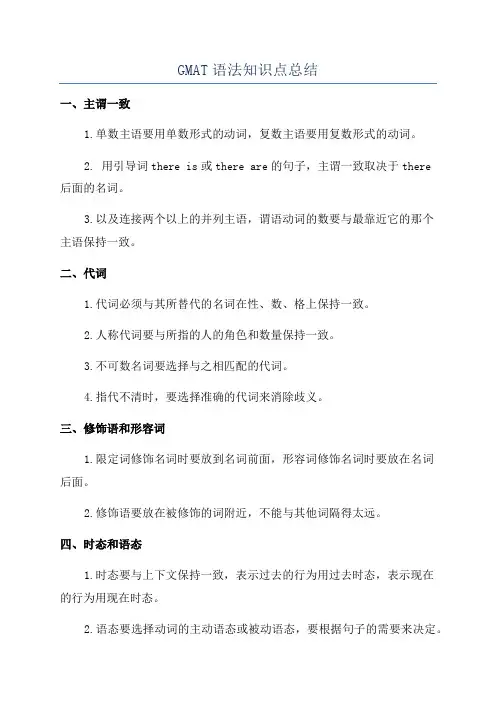
GMAT语法知识点总结一、主谓一致1.单数主语要用单数形式的动词,复数主语要用复数形式的动词。
2. 用引导词there is或there are的句子,主谓一致取决于there后面的名词。
3.以及连接两个以上的并列主语,谓语动词的数要与最靠近它的那个主语保持一致。
二、代词1.代词必须与其所替代的名词在性、数、格上保持一致。
2.人称代词要与所指的人的角色和数量保持一致。
3.不可数名词要选择与之相匹配的代词。
4.指代不清时,要选择准确的代词来消除歧义。
三、修饰语和形容词1.限定词修饰名词时要放到名词前面,形容词修饰名词时要放在名词后面。
2.修饰语要放在被修饰的词附近,不能与其他词隔得太远。
四、时态和语态1.时态要与上下文保持一致,表示过去的行为用过去时态,表示现在的行为用现在时态。
2.语态要选择动词的主动语态或被动语态,要根据句子的需要来决定。
五、介词和介词词组1.介词要选择适当的介词来表示关系。
2.介词短语要与前面的名词或动词保持一致。
3.一些常用的介词词组及其用法要记住。
六、比较级和最高级1.两个人或物进行比较时要用比较级,三个或三个以上进行比较时要用最高级。
2.当被比较的两个人或物不是一个维度时,要对不同的维度分别进行比较。
七、完形填空1.通读全文,先找出文章的中心思想。
2.通读选项,找出和文章相符的选项。
3.根据语境和选项的词义选择最佳答案。
八、句子改错1.根据句子的语法规则和上下文选出错误的部分,然后给出正确的部分。
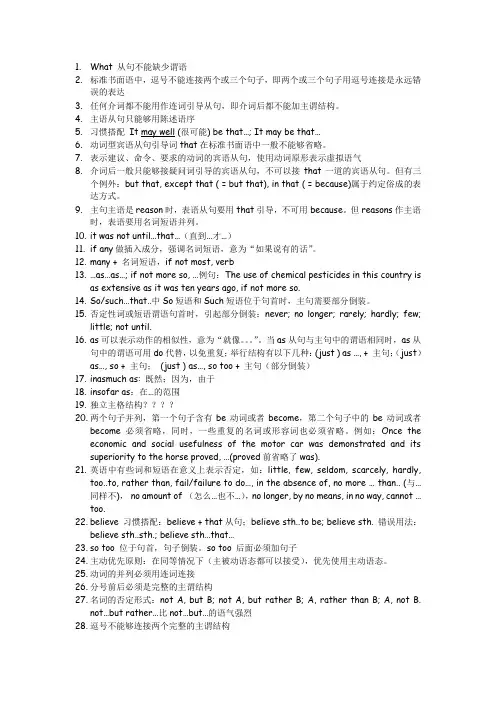
1.What 从句不能缺少谓语2.标准书面语中,逗号不能连接两个或三个句子,即两个或三个句子用逗号连接是永远错误的表达3.任何介词都不能用作连词引导从句,即介词后都不能加主谓结构。
4.主语从句只能够用陈述语序5.习惯搭配It may well (很可能) be that…; It may be that…6.动词型宾语从句引导词that在标准书面语中一般不能够省略。
7.表示建议、命令、要求的动词的宾语从句,使用动词原形表示虚拟语气8.介词后一般只能够接疑问词引导的宾语从句,不可以接that一道的宾语从句。
但有三个例外:but that, except that ( = but that), in that ( = because)属于约定俗成的表达方式。
9.主句主语是reason时,表语从句要用that引导,不可用because。
但reasons作主语时,表语要用名词短语并列。
10.it was not until…that…(直到…才…)11.if any做插入成分,强调名词短语,意为“如果说有的话”。
12.many + 名词短语,if not most, verb13.…as…as…; if not more so, …例句:The use of chemical pesticides in this country isas extensive as it was ten years ago, if not more so.14.So/such…that..中So短语和Such短语位于句首时,主句需要部分倒装。
15.否定性词或短语谓语句首时,引起部分倒装:never; no longer; rarely; hardly; few;little; not until.16.as可以表示动作的相似性,意为“就像。
”。
当as从句与主句中的谓语相同时,as从句中的谓语可用do代替,以免重复;举行结构有以下几种:(just ) as …, + 主句;(just)as…, so + 主句;(just ) as…, so too + 主句(部分倒装)17.inasmuch as: 既然;因为,由于18.insofar as:在…的范围19.独立主格结构????20.两个句子并列,第一个句子含有be动词或者become,第二个句子中的be动词或者become必须省略,同时,一些重复的名词或形容词也必须省略。
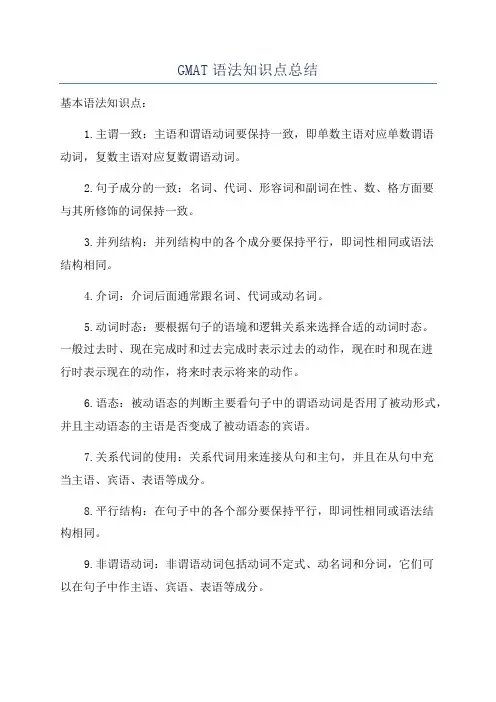
GMAT语法知识点总结基本语法知识点:1.主谓一致:主语和谓语动词要保持一致,即单数主语对应单数谓语动词,复数主语对应复数谓语动词。
2.句子成分的一致:名词、代词、形容词和副词在性、数、格方面要与其所修饰的词保持一致。
3.并列结构:并列结构中的各个成分要保持平行,即词性相同或语法结构相同。
4.介词:介词后面通常跟名词、代词或动名词。
5.动词时态:要根据句子的语境和逻辑关系来选择合适的动词时态。
一般过去时、现在完成时和过去完成时表示过去的动作,现在时和现在进行时表示现在的动作,将来时表示将来的动作。
6.语态:被动语态的判断主要看句子中的谓语动词是否用了被动形式,并且主动语态的主语是否变成了被动语态的宾语。
7.关系代词的使用:关系代词用来连接从句和主句,并且在从句中充当主语、宾语、表语等成分。
8.平行结构:在句子中的各个部分要保持平行,即词性相同或语法结构相同。
9.非谓语动词:非谓语动词包括动词不定式、动名词和分词,它们可以在句子中作主语、宾语、表语等成分。
10.倒装:倒装结构的使用要根据句子的语境和需要来决定,一般有完全倒装和部分倒装两种形式。
11.比较级和最高级:比较级和最高级是用来比较程度的形式,比较级用于两者之间的比较,最高级用于三者或三者以上的比较。
12.并列连词和从属连词:并列连词用来连接两个或多个并列的词、短语、从句等,从属连词用来引导从属从句。
高级语法知识点:1.动词的时态和语态的混合使用:在复杂的语境中,考生可能会遇到动词的时态和语态的混合使用,这时需要根据句子的逻辑确定正确的使用方式。
2.分句和从句的使用:分句和从句在复杂句结构中的使用可以增强句子的表达能力,但需要注意从句和主句之间的逻辑关系和语法关系。
3. 倒装句的多种形式:除了标准的倒装形式,还有一些特殊的倒装结构,如条件状语从句中的倒装、以for、with、without等介词开头的倒装结构等。
4. 强调句型:强调句型主要用来强调句子中的一些成分,通常是利用it is/was…that结构或强调副词强调句子中的一些成分。
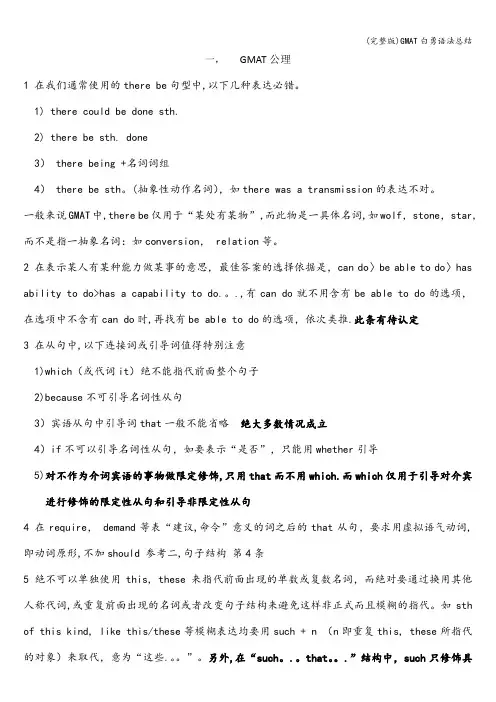
一,GMAT公理1 在我们通常使用的there be句型中,以下几种表达必错。
1) there could be done sth.2) there be sth. done3) there being +名词词组4) there be sth。
(抽象性动作名词),如there was a transmission的表达不对。
一般来说GMAT中,there be仅用于“某处有某物”,而此物是一具体名词,如wolf, stone, star,而不是指一抽象名词:如conversion, relation等。
2 在表示某人有某种能力做某事的意思,最佳答案的选择依据是,can do〉be able to do〉has ability to do>has a capability to do.。
.,有can do就不用含有be able to do的选项,在选项中不含有can do时,再找有be able to do的选项,依次类推.此条有待认定3 在从句中,以下连接词或引导词值得特别注意1)which(或代词it)绝不能指代前面整个句子2)because不可引导名词性从句3)宾语从句中引导词that一般不能省略绝大多数情况成立4)if不可以引导名词性从句,如要表示“是否”,只能用whether引导5)对不作为介词宾语的事物做限定修饰,只用that而不用which.而which仅用于引导对介宾进行修饰的限定性从句和引导非限定性从句4 在require, demand等表“建议,命令”意义的词之后的that从句,要求用虚拟语气动词,即动词原形,不加should 参考二,句子结构第4条5 绝不可以单独使用this, these来指代前面出现的单数或复数名词,而绝对要通过换用其他人称代词,或重复前面出现的名词或者改变句子结构来避免这样非正式而且模糊的指代。
如sth of this kind, like this/these等模糊表达均要用such + n (n即重复this, these所指代的对象)来取代,意为“这些.。
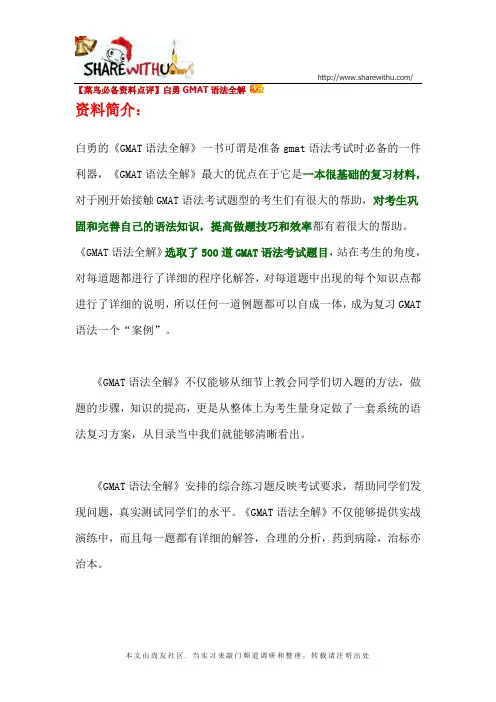
http://www.sharewi t /
本文由尚友社区. 当实习来敲门频道调研和整理,转载请注明出处 【菜鸟必备资料点评】白勇GMAT 语法全解
资料简介:
白勇的《GMAT 语法全解》一书可谓是准备gmat 语法考试时必备的一件利器,《GMAT 语法全解》最大的优点在于它是一本很基础的复习材料,对于刚开始接触GMAT 语法考试题型的考生们有很大的帮助,对考生巩固和完善自己的语法知识,提高做题技巧和效率都有着很大的帮助。
《GMAT 语法全解》选取了500道GMAT 语法考试题目,站在考生的角度,对每道题都进行了详细的程序化解答,对每道题中出现的每个知识点都进行了详细的说明,所以任何一道例题都可以自成一体,成为复习GMAT 语法一个“案例”。
《GMAT 语法全解》不仅能够从细节上教会同学们切入题的方法,做题的步骤,知识的提高,更是从整体上为考生量身定做了一套系统的语法复习方案,从目录当中我们就能够清晰看出。
《GMAT 语法全解》安排的综合练习题反映考试要求,帮助同学们发现问题,真实测试同学们的水平。
《GMAT 语法全解》不仅能够提供实战演练中,而且每一题都有详细的解答,合理的分析,药到病除,治标亦治本。
GMAT语法全总结1.句子结构:句子结构是指句子的基本组成部分和语法规则。
在GMAT语法中,有以下几个重要的方面需要注意:-主谓一致:主语和谓语的单复数要一致。
-定语从句:用来修饰名词或代词的从句,引导词有关系代词和关系副词。
-并列结构:多个句子或词组并列在一起并用逗号分隔。
-状语从句:修饰动词、形容词或副词的从句,引导词有连词、状语从句引导词和状语从句分隔符。
- 虚拟语气:用来表示假设、愿望或建议等,通常用动词的过去时形式或should + 动词的原形。
2.语法错误:在GMAT语法中,有一些常见的语法错误需要注意,包括:-时态错误:如动词时态的误用。
-语态错误:如主动语态和被动语态的误用。
-代词错误:如代词的数、格、性和指代不清楚。
-主谓一致错误:如主语和谓语的单复数不一致。
-并列错误:如并列句的表达不正确。
-修饰错误:如修饰语和被修饰词之间的关系不清楚。
-逻辑错误:如逻辑关系不正确。
3.逻辑关系:在GMAT语法中,语句之间的逻辑关系非常重要。
以下是一些常见的逻辑关系:-因果关系:表示原因和结果之间的关系。
-比较关系:用来比较两个或多个事物之间的差异和相似之处。
-条件关系:表示条件和结果之间的关系。
-排序关系:用来表示事物之间的顺序和优先级关系。
-强调关系:用来强调一些事物的重要性或特殊性。
4.修辞手法:在GMAT语法中,修辞手法是指通过一些特殊的语言技巧来达到修辞效果。
以下是一些常见的修辞手法:-比喻:通过用一个事物来比拟另一个事物,以加强描述的效果。
-排比:通过一系列对比的句子来强调一个观点。
-反问:通过提出一个问题来间接表达观点。
-修辞问句:通过一个令人惊讶的问题来引起读者的兴趣。
-冗余:在句子中重复使用相同的信息,以加强强调效果。
以上是对GMAT语法的全面总结。
掌握GMAT语法规则对于考试取得好成绩非常重要。
在备考过程中,建议根据各个方面的重要程度,制定相应的学习计划并多做练习题,以提高语法能力和应试能力。
GMAT语法总结GMAT考试对于语法的要求非常高,因此在备考过程中需要重点复习和掌握相关的语法知识。
本文将从句子的成分、时态、语态、语法错误类型等方面进行总结和梳理。
一、句子的成分句子由主语、谓语和宾语构成,其中主语用来指明句子的主体,谓语用来表达句子的动作或状态,宾语用来指明动作的承受者或影响对象。
在句子的成分中,需要注意以下几点:1.主语和谓语保持一致,即主语为单数时,谓语动词也应为单数形式。
2.宾语可以是名词、代词或从句,需要根据具体语境来确定正确的形式。
3.宾语的位置可以在句子的中间或末尾,但不能放在句子的开头。
二、时态的使用时态是表达动作发生的时间的一种方式。
在GMAT中,时态的使用要遵循以下几个原则:1.一般过去时用于表达过去的真实情况,一般将动词的过去式形式作为谓语动词。
2. 现在完成时用于表达过去发生的动作与现在产生的影响或结果之间的关系。
通常使用have/has + 过去分词来构成现在完成时的句子。
3. 一般将来时用于表达将来会发生的动作或状态。
通常使用will/shall + 动词原形来构成一般将来时的句子。
4. 现在进行时用于表达现在正在进行的动作。
通常使用be + 现在分词来构成现在进行时的句子。
三、语态的使用语态是表达主语和动词之间关系的一种方式。
在GMAT中,语态的使用要遵循以下几个原则:1.主动语态用于强调动作的执行者。
通常使用主动语态的句子结构为:主语+动词+宾语。
2. 被动语态用于强调动作的接受者或影响对象。
通常使用被动语态的句子结构为:宾语 + be + 过去分词(动词的第三形式)。
3.在使用被动语态时,要注意将及物动词变为被动形式,并且要保持动作的一致性和逻辑性。
四、常见的语法错误类型在GMAT语法中,常见的语法错误包括并列结构错误、主谓一致错误、代词一致错误、动词时态错误、语态错误等。
以下是对这些错误类型的具体总结:1. 并列结构错误:指在使用并列连接词(如and、but、or等)连接两个或多个句子时出现的错误。
新东方语法笔记语法复习考试最佳时间:9-10月份复 习、消化时间为两个月最好组成学习团队先将课堂所讲的所有语法规则复习一遍。
将所有做错的题目重新做一遍,至少看两遍,注意做标记。
每道题目的重点复习一遍。
先不要做题,先看每道题的考察重点, 根据题目考察重点寻找各选项的错误,加强语法规则的记忆。
分解、背诵各句子的结构。
可以采用背诵题目并默写于电脑上的办法。
将剩下的题目做一遍,进行水平检测。
将蓝皮书和白皮书的内容做两遍。
模考,专心做光盘,不要执着于对错,注重做题时间的控制。
byronwhite@ <mailto:byronwhite@>句子结构完整性1、主语+谓语,句子的两个主要成分不可缺少4、比较从句常省略形式:A is richer than B is.5、状语从句常省略形式:I drink while driving.6、注意时态问题7、情态动词保留解题思路1、先看句子结构(语法)和逻辑结构2、若无错,则比较各个选项。
解题步骤1、准确性:1)符合语法规则2)用词准确2、有效性1)逻辑意思清晰2)表达简洁3)意思单一解题的思维习惯1、符合语法规则否?2、用词准确否?3、表达有效否?阅读方法:抛弃式阅读法1、抓住主谓部分2、抛弃修饰性成分4)定语:形容词/名词/分词短语/介词短语/定语从句6)状语:副词/分词短语/不定式/介词短语8)同位语结构10)插入成分3、回避生词和不能理解的部分/结构5、有意识关注易出错的地方1) 代词指代3) 定语从句的引导词/连接词等4) 平行结构何时采用全倒装形式1、介词短语2、分词短语3、形容词短语be动词+主语代词指代对象查找顺序1、主语的核心词2、宾语和表语3、修饰成分中的名词4、当两个句子或三个句子并列时,第二句或第三句中的代词应优先指代第一句中的名词独立主格结构1、位置:句首或句尾2、作用:状语3、表示:原因、条件、状态、结果4、模式:名词+名词、名词+分词、名词+形容词短语、名词+介词短语主句和从句时态协调1、主句时态决定从句时态2、从句时态决定主句时态3、主从句时态不一致,必须有明确的时间线索。
一,GMAT公理1 在我们通常使用的there be句型中,以下几种表达必错。
1) there could be done sth.2) there be sth. done3) there being +名词词组4) there be sth.(抽象性动作名词),如there was a transmission的表达不对。
一般来说GMAT中,there be仅用于“某处有某物”,而此物是一具体名词,如wolf, stone, star,而不是指一抽象名词:如conversion, relation等。
2 在表示某人有某种能力做某事的意思,最佳答案的选择依据是,can do>be able to do>has ability to do>has a capability to do...,有can do就不用含有be able to do的选项,在选项中不含有can do时,再找有be able to do的选项,依次类推。
此条有待认定3 在从句中,以下连接词或引导词值得特别注意1)which(或代词it)绝不能指代前面整个句子2)because不可引导名词性从句3)宾语从句中引导词that一般不能省略绝大多数情况成立4)if不可以引导名词性从句,如要表示“是否”,只能用whether引导5)对不作为介词宾语的事物做限定修饰,只用that而不用which。
而which仅用于引导对介宾进行修饰的限定性从句和引导非限定性从句4 在require, demand等表“建议,命令”意义的词之后的that从句,要求用虚拟语气动词,即动词原形,不加should 参考二,句子结构第4条5 绝不可以单独使用this, these来指代前面出现的单数或复数名词,而绝对要通过换用其他人称代词,或重复前面出现的名词或者改变句子结构来避免这样非正式而且模糊的指代。
如sth of this kind, like this/these等模糊表达均要用such + n (n即重复this, these所指代的对象)来取代,意为“这些...”。
另外,在“such...that...”结构中,such只修饰具体名词,而不修饰抽象名词(如rapidity, severity)6 绝对不可以单独使用that指代前面的单数或不可数名词,而一般是用that of + n..结构指代或换用其他表达方式。
如I just borrowed a book from library yesterday, but now I cannot find it.此句中it=a book,但此处绝不可以用that来替换。
并且在标准书面语中,that永远不能单独充当主语7 当我们需要举例时,一律用such as结构,而不用like, like只能表示比较。
8 主动优先原则9 在GMAT中关于being的以下使用必然错:1) being + n. 2) being + adj. 3) as being + n./adj./v-ing,因为在以上表达中being属于多余。
one’s being done 也错10 当我们对一动宾结构进行替换时,do + 代词(it/this/that/these/those等)在标准书面语中永远错,一律用do so11 介词短语:on account of, because of, despite (in despite of), as a result of之后只跟简单的名词短语。
若其后面跟的是动名词或名词所有格+动名词短语(sb’s doing),或名词短语之后用一复杂的现在分词来修饰时,应改为与其相同意义的连词because, although等引导的从句形式。
12 几种简洁的表达方式:1)n..that is (are) adj. 必然要换为adj.+ n.的名词短语结构,如:a man who is poor的选项必错,而应选含有a poor man的选项2)当表示谓语部分,尤其时表示实义动词的含义时,就直接用其动词形式表示,而不要用名词形式或形容词形式表示,如:be a cause一定会被cause(动词)替代;be suggestive of就一定会被suggest所替代3)一些常见词的替换方式:not any一定会被no替代; that which一定会被what替代;having been done会被done(做限定词)所替代whether or not被whether替代13 平行结构的最后一个成分之前必定有一个连词and, or, neither, nor或as well as,否则此并列结构必然存在问题。
如:to do A, do B, do C的表达就必然错误14 选项中有rather than的一定优于含有instead of的选项15 若在题中的划线部分(即A选项)中出现情态动词,那么在最后的正确答案中必须有此情态动词或类似语气的词出现。
实战中,此原则可以转化为:不含此情态动词或类似语气词的选项均为错误选项,立即排除。
情态动词也不可随意添加,原句中没有情态动词,选项中有也为错误选项。
二,句子结构1 主语从句只能使用陈述语序ex: what I did was…… what did I do was……错2 习惯搭配:it may well (很可能)be that……3 宾语从句的时态可以与主句谓语动词不一致。
表示客观存在﹑科学事实﹑统计数据﹑研究结论﹑商业惯例等常用一般现在时。
4 表示建议﹑命令﹑要求的动词的宾语从句,使用动词原形表示虚拟语气(美国标准书面语中必须省略动词原形前的should)1)表建议:advocate/advise/move(提出议案:按国会的程序作出正式提议)/recommend that…do…; sb. suggest/propose that…do…2)表命令:order/decree/mandate/command/demand that…do…3)表要求:request/require/insist that…do…; sth. r equire of sb. that…do…下列动词后的宾语从句不用虚拟语气:allow that…; allow在此意为承认sth. propose that...; sth.. suggest that 注意同sb. suggest/propose that…do…对比5 介词后一般只能接疑问词引导的宾语从句,不可以接that引导的宾语从句。
ex. to which I look, from where I got 但有三个例外:but that, except that (=but that), in that (=because) 属于约定俗成的表达方式。
6 若宾语从句后跟有补语,通常用形式宾语it来代替:...make it clear that7 if any:作插入成分,强调名词短语,意为“如果说有的话”8 独立主格结构1)独立主格结构放在句首或句尾,起状语作用,表伴随原因﹑条件﹑状态等。
2)一般独立主格,与主句形成松散的逻辑关系,形式为:n.+ n.; n. + -ed/ing形式; n. + 介词短语;n. +形容词短语3)with型独立主格,与主句形成紧密的逻辑联系,形式为:with + n. + -ed/ing形式; with + n. + adj.; with + n. + 介词短语作状语修饰前一个分句的动作类型词例:Visitors to the park have often looked into the leafy canopy and seen monkeys sleeping on the branches, with arms and legs hanging like socks on a clothesline.with引导的独立主格作状语就近修饰sleeping。
4)each型独立主格,强调句尾名词,形式为:句子+ 复数名词结尾, each + 介词短语/形容词短语/-ed形式/-ing形式。
例:Chinese, the most ancient of living writing systems, consists of tens of thousands of ideographic characters, each character a miniature calligraphic composition inside its own square frame. 独立主格形式n + n 与主句形成松散逻辑关系9 两个句子并列,第一个句子含有be动词或者become,第二个句子中的be动词或者become必须省略,同时,一些重复的名词或形容词也必须省略。
例如:Once the economic and social usefulness of the motor was demonstrated and its superiority to the horse proved, ... (proved前省略了was)注意:be able/unable to是be动词短语,在这个短语中be动词不是助动词,不能省略!例:A president entering the final two years of a second term is likely to be at a sever disadvantage and is often unable to carry out a legislative program.10 believe的习惯搭配:believe + that从句;believe sth. to be; believe sth错误用法:believe sth. sth.; believe sth. that...11 动作的目的关系用to do表示,用for doing表达错12 动词的并列必须用连词连接白勇P16 713 not...but rather...比not...but...语气强14 分号可以连接两个完整的主谓结构:like many others..., Mr. K lived in...(句子1);born into...and instructed in..., he also received...(句子2)15 习惯用法:permit sb.to do sth.16 习惯用法:phenomenon的定语从句的关联词只能使用in which17 习惯用法:access to do access for sb.错18 习惯用法:take turns doing19 hopefully在口语种表达两个意思,1 充满希望的2 人们希望的在书面语中为保证意思的单一性,一般不使用hopefully20 hope在书面语中的用法,it is hoped that...,it 作为形式主语指代后面的that从句;it is hoped 作为插入语,前后用逗号隔开。